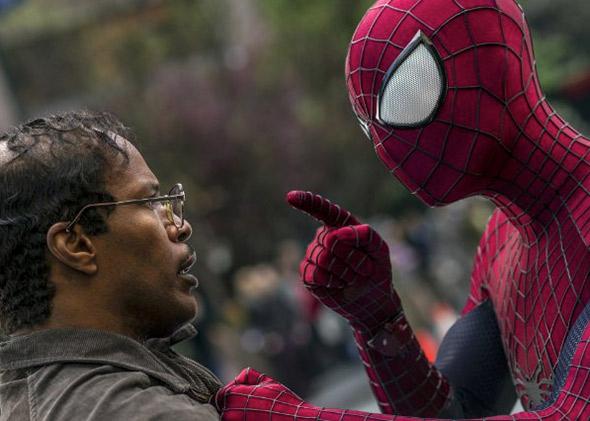Ten years ago this summer, Sam Raimi’s Spider-Man 2 was released and quickly became perhaps the most critically acclaimed and popularly beloved comic-book superhero movie since Richard Donner’s Superman in 1978. Spider-Man 2 had it all: a cracking villain in Alfred Molina’s multitentacled Doc Octopus, a sparky romantic connection between leads Tobey Maguire and Kirsten Dunst, and a script by the Academy Award–winning screenwriter Alvin Sargent (with story contributions from, among others, the comics-obsessed novelist Michael Chabon) that balanced the action and special-effects demands of a summer blockbuster with a sweet, smart human story. Spider-Man 2 was the movie that made people who didn’t grow up reading comics get what was fun about the genre in the first place.
The relatively fresh memory of that Spider-Man can’t help but lessen the purported amazingness of Marc Webb’s The Amazing Spider-Man 2, the second chapter of a drearily unnecessary franchise reboot that creaked into motion in 2012 (in large part, it seems, because Sony was contractually obligated by Marvel to make a Spider-Man movie at certain intervals in order to hold onto its rights to the character). Maybe every generation gets the Spider-Man it deserves, but must every micro-generation? Andrew Garfield’s scruffy, sincere kid-with-a-backpack incarnation of the Peter Parker/Spider-Man character isn’t so different from Tobey Maguire’s that it constitutes a reinvention. And most of this movie’s action sequences, in which a web-slinging Spidey swoops gymnastically among Manhattan skyscrapers to yank unsuspecting pedestrians out of the path of hurtling vehicles, closely recall the visual thrills of the 2004 Raimi film (allowing for the advances in digital effects that have been made since).
But there’s no use shaking your fist at the heavens (or even more futilely at Sony/Marvel) and demanding why this Spider-Man franchise needs to exist. It does, and its existence provides for a few small pleasures, even if the project as a whole conveys a drab sense of bureaucratic necessity, a “let’s get this over with” wheeziness. Andrew Garfield and Emma Stone—who have become an item in real life since the last movie, to the joy of the tabloids—seem to interact within a charmed, charged space: When they flirt with each other, it feels real. That could have been the basis for a genuinely memorable romantic storyline, but Garfield and Stone aren’t given enough good dialogue to speak. They tend to trade lovey-dovey compliments rather than screwball-comedy barbs. It’s as if there was a script meeting where someone threw up his hands and said, “Eh, just let ’em be cute together.” Stone has a knack for giving a just-OK line a dry Rosalind Russell snap, and her character, the valedictorian and molecular-biology whiz Gwen Stacy, does get in a few amusing retorts. But Garfield, a tremendously appealing and intelligent presence in The Social Network, seems misplaced and a bit wasted as a human arachnid. In a scene in which Peter pries a painful family secret out of his beloved Aunt May (a very good Sally Field), you get a glimpse at how well Garfield can act when the neoprene hood is off, and hope that when this franchise is over he takes the money and sprints in the direction of something more interesting.
Like the disappointing last chapter of the Raimi trilogy, Amazing 2 suffers from villain glut, with Garfield’s Spidey battling at least three separate super-antagonists. His childhood friend Harry Osborn (Dane DeHaan), the petulant young CEO of ominous genetic-engineering company Oscorp, has a rare and fatal condition that, after he attempts to treat it himself in the lab, has him mutating into a sky-surfing green imp called the Hobgoblin. Max (Jamie Foxx), a nerdy low-level electrical engineer at Oscorp, falls into a vat of electric eels (on his birthday, no less), leading to his transformation into Electro, a glowing blue figure capable of dematerializing and traveling through the city’s electrical grid in the form of a current. Way too late in the film, Paul Giamatti lumbers onto the screen in a dinosaurlike suit of mechanical armor as the fearsome yet curiously adorable Rhino. It’s a throwaway action scene clearly inserted in order to tease the next Spider-Man movie—and strangely enough, for this capes-and-tights-weary viewer, it kind of worked. Paul Giamatti can get me into the theater to see almost anything. Call it a superpower.
